
幕末の風刺漫画誌から同人誌まで、マンガメディアの変遷をたどる。
The evolution of the manga medium, from cartoon magazines from the Bakumatsu period to doujinshi


2010年4月、マンガミュージアムでは、開架書棚の増設など大幅なリニューアルを行ったが、中でも目玉となったのは、「マンガって何?」という来館者の疑問にさまざまな視点から答えるメイン展示の新設。マンガの歴史や社会的意義、読者の目にはなかなか触れない作画過程や産業構造など、外国人来館者や小中学生にも理解してもらえるような"マンガ入門"展示となっている。
また、会場となっているメインギャラリーの壁面に設置された書棚には、『現代漫画博物館』(小学館、2006年)に基づき、1945年〜2005年の各マンガ賞受賞作を中心とした名作マンガを年ごとに配架。戦後マンガの歴史を俯瞰し、その成長・発展を通覧できる構成となっている。
In April 2010 the Manga Museum renovated on a large scale, by a.o. increasing open shelf space, and one of the main points of focus was the "What is Manga?" Exhibition. It is a new exhibition that seeks to answer questions that visitors may have from various perspectives. It is an 'introduction to manga' exhibition that is accessible to foreign visitors as well as middle students, and explains about manga history, manga's social significance, things the average reader doesn't normally get to see like the process through which manga are created and mass produced, and more.
The exhibitions space is the main gallery, of which the walls are covered in book shelves filled mainly with popular and awarded manga from 1945 to 2005, arranged by year (based on Gendai Manga hakubutsukan, 2006, Shogakukan). The exhibition provides visitors with a survey of the history of postwar manga, and its structure reflects the growth and development of manga.

幕末の風刺漫画誌から同人誌まで、マンガメディアの変遷をたどる。
The evolution of the manga medium, from cartoon magazines from the Bakumatsu period to doujinshi

年齢・性別で細かくセグメントされた日本のマンガ雑誌の多様性を紹介。
Introduced the diversity of Japanese manga magazines, carefully segmented by age and gender.
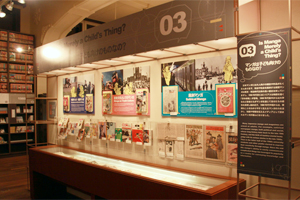
政治風刺や情報伝達など、マンガが娯楽以外に持っている社会的機能を紹介。
Introducing social functions of manga other than entertainment, like political satire and spreading of information.
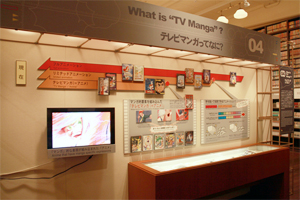
マンガの技法を取り入れた日本独特のアニメーションである「アニメ」について解説。
The unique to Japan form of animation, 'anime' which incorporates many of the techniques of manga, is explained.

マンガの作画工程を実際の作例や作画風景の映像、主な道具の実物などで紹介。
Introducing the process of manga making with real examples of works, video of the work space, and tools.

人物の感情や動きを表す「漫符」や、コマ割りの法則など,マンガの決まりごとを解説。
An explanation of the fundamental principles of manga, like how characters' emotions and movements are expressed, the rules of panels lay-out, and other conventions of the manga genre.
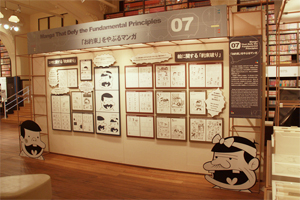
赤塚不二夫のギャグマンガを素材に、決まりごとからはみ出すマンガの魅力を紹介。
Showing the appeal of manga that defy conventions through the works of Akatsuka Fujio, a gag manga artist.
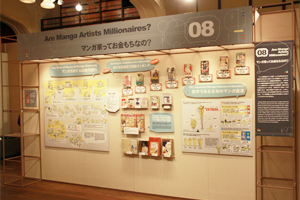
マンガが、多くの企業が関わる一大産業であることを統計資料などで紹介。
We explain how manga are a large industry in which many companies are involved by showing some statistic material.

メディアミックスやキャラクタービジネスなどの日本マンガの産業構造を解説。
An explanation of the structure of Japan's manga industry, of which media mix and merchandizing of manga characters are part.

欧米・日本・アジアそれぞれのマンガが国際的に影響を与えあってきた様子を紹介。
We show how the manga of Europe, the U.S., Japan, and Asia have all influenced each other.
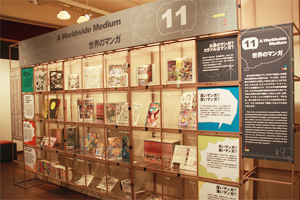
日本の「マンガ」以外の「コミックス」や「バンド・デシネ」など、多様なスタイルとメディアを紹介。
We introduce 'manga' that aren't Japanese, in diverse styles and media, like comics and Bandes dessinées.